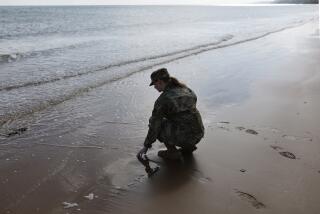Old Enemies in the Sky Meet on Friendlier Terms
- Share via
The young sheriff’s deputy wanted more than an autograph Sunday.
Very politely, he asked the old British fighter pilot to also write down a number--the number of “victories” he had recorded in the war.
Very politely, Peter Townsend declined.
“I’d rather not put the number of victories,” Townsend said as he signed his name, “because, you see, victories meant killing young men.”
Fifty years after they held a war and everybody came, Townsend’s message was clear:
To honor history is one thing. To glorify bloodshed, another.
But how, exactly, does one separate the two?
After all, it was fascination with World War II, that most adrenalized, decisive chapter of history, that drew 1,000 people to the Long Beach Elks Lodge for an unusual gathering of six aces--three from the Royal Air Force, three from the dreaded German Luftwaffe.
The occasion was an art show and symposium commemorating the Battle of Britain. The event was sponsored by a Virginia-based gallery, Virginia Bader Fine Arts, which specializes in images depicting aerial combat.
The RAF was represented by Group Capt. Townsend, Group Capt. (now Sir) Hugh Dundas and Wing Cmdr. Donald E. Kingaby.
The Luftwaffe was represented by three generals: the flamboyant Adolf Galland, who at age 29 commanded the Luftwaffe fighters; and Dietrich Hrabak and Guenthar Rall, both of whom went on to represent West German forces in NATO.
Combined, the six featured guests had shot down more than 500 aircraft during the war.
Those who would, in 1990, still revile the Luftwaffe commanders may not understand history, suggested Dave Hutton of Whittier, a collector of World War II memorabilia. They were not Nazis, but young military men who happened to serve in Hitler’s Germany, he said.
“These men have seen a lot and they won’t be around much longer,” Hutton said.
They have lasted long enough, however, to see the drama of current developments in Europe. And in brief interviews, the aces expressed satisfaction with the triumph of democratic ideals.
“After all, we got into the war in ’39 for the Poles, and now they’re finally free,” Dundas said.
As he signed portraits of Spitfires in combat, his wife, Robby, sat beside him, needlepointing floral designs.
As for the prospects of a reunited Germany, “well, they’re very keen about it,” said Robby Dundas, referring to the Germans.
“I think it ought to be taken very slowly with lots of safeguards for people like the Poles and the Czechs.”
Reunification should happen, Rall said, but “only with the consensus of our neighbors and friends.”
Memories of the German aggression do not fade quickly.
Helen Kingaby, who married Donald 48 years ago at the height of the war, recalled watching aerial combat overhead and seeing some Spitfires come down in flames, not knowing if one contained her husband. It was, she said, “a rather different experience.”
More to Read
Sign up for Essential California
The most important California stories and recommendations in your inbox every morning.
You may occasionally receive promotional content from the Los Angeles Times.













